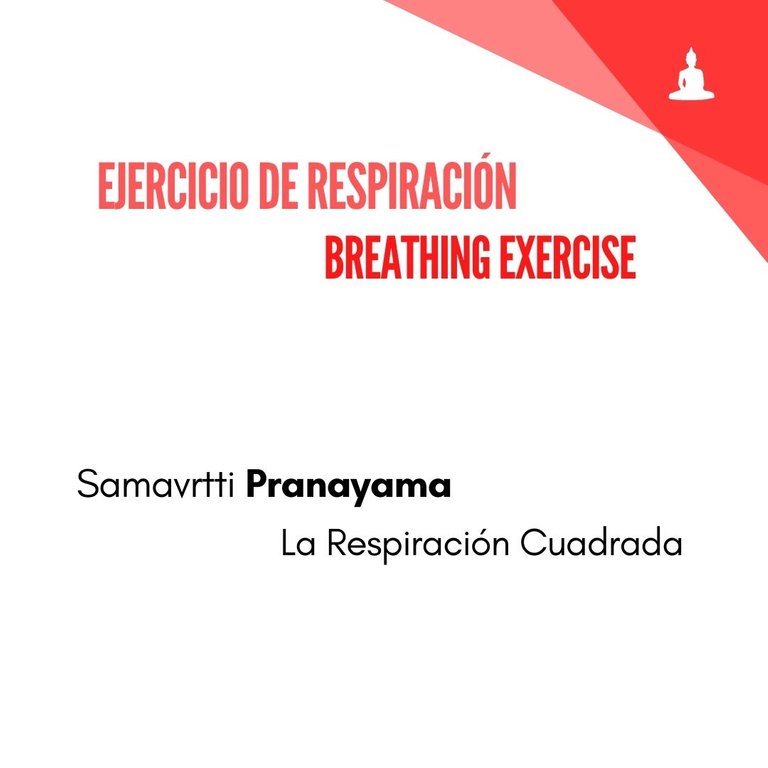Ejercicio de respiración armónica; SamaVrtti Pranayama - Harmonic breathing exercise; SamaVrtti Pranayama [ES/EN]

Pocas veces hablo fuera de mis clases sobre Pranayama, y para que podamos entender el contexto de lo que es un Pranayama comenzaré por hacer la aclaratoria:
El pranayama es el conjunto de técnicas usadas en el Yoga, que permite a través de acciones específicas en nuestra respiración, controlar la energía que adquirimos. Por lo general se define Pranayama como el control o expansión de la respiración pero realmente son técnicas para controlar y expandir la energía vital -o prana- que recibimos cuando estamos respirando.
Con este ejercicio de respiración cuadrada o como es mejor conocido en el Yoga: SamaVrtti Pranayama, podemos conseguir el equilibrio en distintos niveles:
-Equilibrio de la mente, al realizar las etapas de la respiración en los mismos tiempos. Haciéndo así que nuestra mente encuentre armonía en los pensamientos que surgen de ella.
-Esto otorga equilibrio en el sistema nervioso, lo que trae como consecuencia paz y calma física y mental.
Además, realizar este ejercicio con frecuencia potencia nuestra capacidad de concentración, ya que para lograr igualar las 4 fases de la respiración sin perdernos es necesario estar muy concentrados.
Supone también una limpieza, purificación y oxigenación completa, mejorando así la calidad de nuestra sangre y optimizando así el estado de nuestro organismo (incluido el cerebro).

Es una técnica sencilla, pero muy efectiva, y podemos practicarla todos los días sin complicación, durante no más de 10 minutos por día.

La respiración cuadrada se realiza en cuatro etapas y te sugiero para comenzar con 4 segundos de duración cada una y se realiza siempre por la nariz:
-Etapa 1: Toma el aire inhalando profundamente por la nariz durante 4 segundos. (linea verde)
-Etapa 2: Retén el aire durante otros 4 segundos más. (linea roja)
-Etapa 3: En la exhalación, vaciamos por completo los pulmones durante 4 segundos también. (linea verde)
-Etapa 4: Manten los pulmones sin aire otros 4 segundos más. (linea amarilla)
Es muy importante que todas las etapas de la respiración duren lo mismo.
Siempre verifica que estes con comodidad durante la inhalación y la exhalación. Si notas que alguna de las etapas te cuesta demasiado, reduce el tiempo de todas por igual. Si no son todas iguales ya no estarías conformando un cuadrado, y la armonía del pranayama se pierde. Por eso es muy importante que el tiempo, de ser cambiado, sea cambiado para todas las etapas. Según vayas adquiriendo práctica, podrás añadir algún segundo si quieres.

I rarely talk outside of my classes about Pranayama, and so that we can understand the context of what a Pranayama is I will begin by making the clarification:
Pranayama is the set of techniques used in Yoga, which allows through specific actions on our breath, to control the energy we acquire. Usually Pranayama is defined as the control or expansion of the breath but they are really techniques to control and expand the vital energy -or prana- that we receive when we are breathing.
With this square breathing exercise or as it is better known in Yoga: SamaVritti Pranayama, we can achieve balance on different levels:
-Balance of the mind, by performing the stages of breathing at the same times. Thus making our mind find harmony in the thoughts that arise from it.
-This gives balance in the nervous system, which brings as a consequence peace and physical and mental calm.
In addition, doing this exercise often enhances our ability to concentrate, because to achieve equalize the 4 phases of breathing without getting lost is necessary to be very concentrated.
It also involves a complete cleansing, purification and oxygenation, thus improving the quality of our blood and optimizing the state of our body (including the brain).

It is a simple technique, but very effective, and we can practice it every day without complication, for no more than 10 minutes per day.

Square breathing is performed in four stages and I suggest you to start with 4 seconds duration each and is always performed through the nose:
-Stage 1: Take in air by inhaling deeply through your nose for 4 seconds. (green line)
-Stage 2: Hold your breath for another 4 seconds. (red line)
-Stage 3: On the exhalation, completely empty the lungs for 4 seconds as well. (green line)
-Stage 4: Keep the lungs without air for another 4 seconds. (yellow line)
It is very important that all stages of breathing last the same amount of time.
Always check that you are comfortable during inhalation and exhalation. If you notice that any of the stages are too difficult, reduce the time of all of them equally. If they are not all equal, you are no longer forming a square, and the harmony of the pranayama is lost. That is why it is very important that the time, if changed, is changed for all the stages. As you acquire practice, you can add a second if you want.

Soy Julio Cesar Arvelo, practicante y profesor de Ashtanga Yoga y Meditación.
- Si te gustó este post y quieres seguir leyéndome, bienvenido a seguirme.
I am Julio Cesar Arvelo, practitioner and teacher of Ashtanga Yoga and Meditation.
- If you liked this post and want to keep reading me, welcome to follow me.
Mi redes sociales:

MINDFUL LIFE is a Natural Medicine project which supports meditators on HIVE
Discord II Community